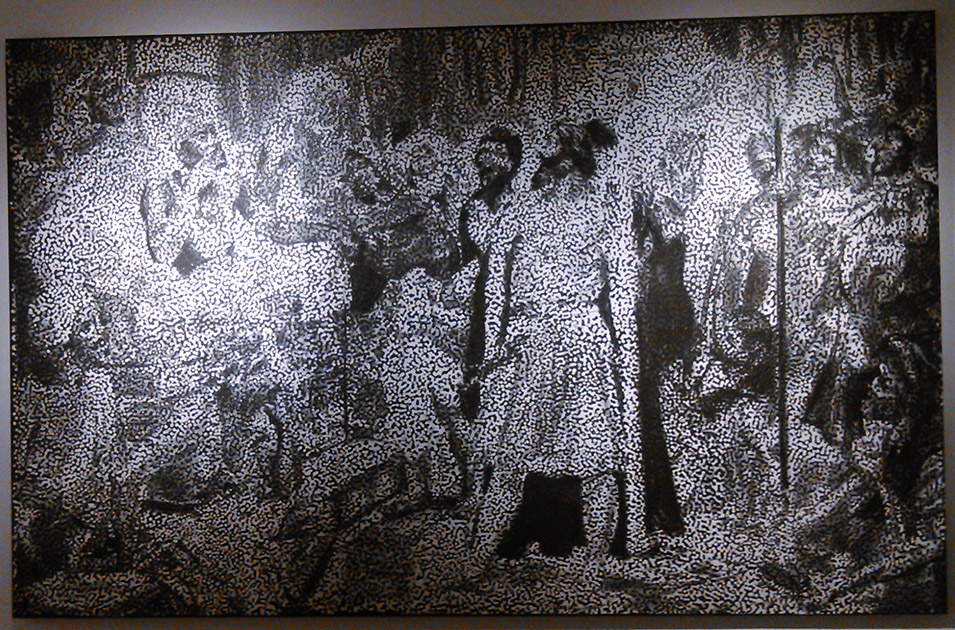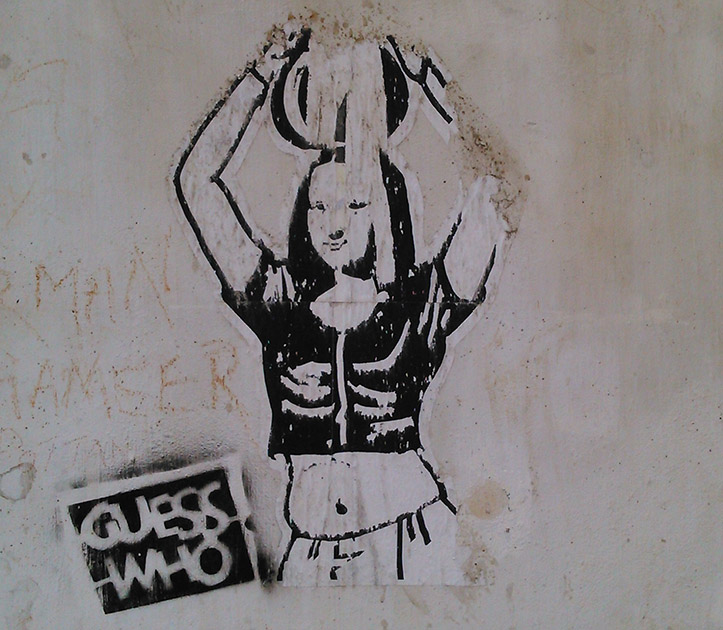Deepa Bhasthi visits the Kochi-Muziris Biennale 2014 which is in its second edition and studies the artworks on display. From Anish Kapoor’s gravity-defying Descension to Marie Velardi’s 21st century world crafted from science fiction, she describes the awe-inspiring festival of images …
Every country seems to want one. It’s a bit like the space program, you need to have your own to be able to fully believe you have ‘arrived’, so it would seem. And so we have our own biennale, the Kochi-Muziris Biennale that opened December 12 from a gorgeous platform just by the Arabian Sea, to the stupendous sound of 300 performers piercing the air with drums, horn trumpets and other traditional musical instruments. It rained on the parade, but the heat and humidity of the coast abated little. It rained too on the bar at the adjacent club where the party was, but that is another story.
The Kochi-Muziris Biennale (KMB) is in its second edition this year. The first time around, there was utter chaos. Nothing was organised, there was no schedule printed, most works were not up and there was mad chaos, people in the know tell me, even two years on; I didn’t go, in 2012. This time around, there is a schedule but several works remain stuck in customs. Oh, let me not nitpick, a home grown brand needs some slack; I’ll allow that a biennale is not a small thing to organise.
Well known artist Jitish Kallat curates the biennale. There could not have been a prettier venue than the sea-wind weathered warehouses, old trading offices and expansive halls that fill Fort Kochi. Kappad in Calicut was where Vasco da Gama landed in the late 15th century, in the maritime Age of Discovery, seeking spices and untold wealth that travellers had promised there existed on the Malabar shores. His arrival in the court of the Zamorin of Calicut started a long period of trade, conquest and eventual colonisation of the country.
The scene, that of a traveller from distant shores, in a rich court, is much mythologised over the centuries. An 1898 painting of this imagined moment by Jose Veloso Salgado lends itself to interpretation by two artists at the biennale, Pushpamala N and Daniel Boyd. The former recreates the painting in a photograph, changing the now historically legitimate scene back into fiction, a product of imagination. Boyd, an Australian artist of Aboriginal ancestry, employs his recurring motif of resin dots over a painted image before painting the whole surface in black to trigger questions and connections that animate and unravel dominant narratives that surround the Age of Discovery.
Kallat’s curatorial vision starts from these new discoveries and expands to the next century when astronomer-mathematicians from what would come to be known as the Kerala School of Astronomy and Mathematics were making steady advances in trigonometry and calculus, helping further understand the planet and enabling the placing of humankind within the wider cosmos. The works in the biennale draw a cluster of signs, images and metaphors from these references, alluding to the historical, the cosmological and deliberating on the axes of time and space to interface the bygone with the imminent, the terrestrial with the celestial. ‘Whorled Explorations’ is the theme and the works explore the various dimensions and narratives of space, celestial, time and history and trade that the region has experienced, and through it, other contexts.
The Aspinwall House, a gargantuan complex from the 1860s is where over 50 artists show their works. One of the star attractions of the biennale, Anish Kapoor’s Descension (2014), is a water vortex that seeks to destabilise the experience of having solid ground below, drawing the viewer in, juxtaposed with the calm waters of the Periyar River at the other end. Across the hall is N S Harsha’s gigantic 79-feet long painting Punarapi Jananam Punarapi Maranam (2013), an infinite loop of the universe that holds a galaxy of stars and the planets in a never-ending procession through space and time. Yoko Ono, who does not make an appearance, is distributing her iconic Earth Piece: Listen to the sound of the earthturning (1963/1999) postcards as takeaways. I take away two, to give a friend, to stick one on the fridge. Francesco Clemente, the nomadic artist, continues with his experiments with the form and structure of a tent. His Pepper Tent (2014) is a bright pink tent covered in paintings of stars and high seas and human bodies, made in his studio in Brooklyn and assembled in Rajasthan by Indian tent makers.
From the celestial to more earthly matters, there are the brilliant photographs of Dayanita Singh. 1.9.2014 Dear Mr Walter(2014) is not a museum, instead, the pictures, arranged upon pillars, choreograph the viewers’ encounter and engagement by reinventing the space of photography as sculpture and architecture. Then there is the marvelous work of Bengaluru-based artist Sunoj D, called Zero to the Right(2014), an articulation in sound and drawing of a sum of $2000, his production budget during a Dubai residency – where the project was conceived – converted into Dirhams and Indian rupees. The recitation of 2000 USD in English, 7,346 Dirhams in Arabic and 1,25,427 Indian rupees in Malayalam, all playing simultaneously from three connected rooms, is a meditation on time, labour and iniquity. There are drawings on the wall accompanying the sound pieces, both evoking the long standing relationship that the migratory labour from Kerala to the Middle East has had with the homeland’s economy and social structures.
Well known illustrator K M Vasudevan Namboodiri offers glimpses of Kochi through a series of drawings of relics of the colonial era, street scenes, waterways and markets while Aji V N’s mesmerising charcoal on coloured paper landscapes transform everyday earthly imagery into phantasmagorical, broody visions. One of my favourites was Marie Velardi’s Future Perfect, 21st Century, a 2006 work that gives a timeline of the 21st century culled from science fiction books and movies of the 20th century. Some of the scenarios she spells out are eerily plausible; some are outright funny, some plain absurd. Yet, none can be completely dismissed. Playful at times, yet profound, the artist as a cartographer imagines a eccentric mix of what might happen to the world – ranging from complete collapse of civilisation to migration to Mars to a world where everyone speaks Portuguese.
Gigi Scaria’s Chronicle of the Shores Foretold (2014) is composed of a bell hoisted by bamboo poles, punctured – symbolically puncturing time – to spout a fountain, orchestrating a confrontation between several overlapping episodes from Malabar’s history, from the trade links to transformative cultural influences. Other well-known artists like Mona Hatoum, Hema Upadhyay, Charles and Ray Eames, Gulammohammed Sheikh, K G Subramanyan, Valsan Koorma Kolleri, Sahej Rahal, Nikhil Chopra, Mona Hatoum, Navjot Altaf, William Kentridge and others show their works too, spread across eight venues, that include dedicated areas for the children’s and students’ biennales.
The second edition of the KMB evokes sharply the dual transience and permanence of time and space in the works it has chosen to include. What perhaps best sums up not just the biennale, but in some sense the art in life itself is Martin Creed’s as usual quirky work, Work No 232:the whole world+ the work = the whole world(2000). The ambiguity he presents makes you want to try to ponder, as you stand before Darbar Hall, if art works are inseparable from the world or not or whether the ‘whole world’ is any different a place by the addition of the work. The ‘work’ could be replaced by any human endeavour and the same questions could be asked again. Would it matter? That such questions arise is what perhaps makes the biennale, or any place with art, matter.
Artwork in the featured image: Daniel Boyd.















